AMD Delivers Crimson ReLive Drivers: Yearly Feature Update for Radeon Gamers and Professionals
by Ian Cutress on December 8, 2016 9:00 AM EST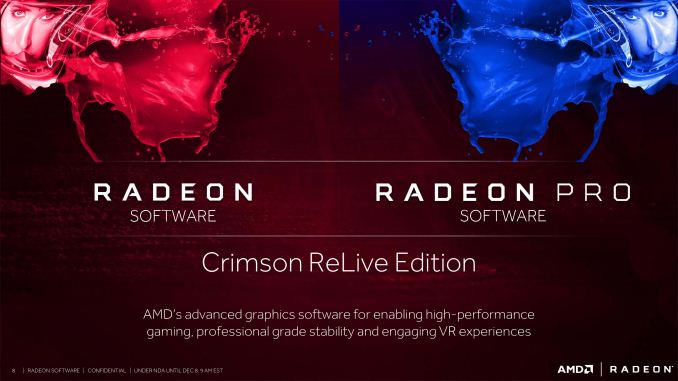
This time last year we saw the launch of Radeon Crimson. This was AMD’s big attempt to state that a yearly cadence for software features was a good thing, and helped streamline the process for the number of initiatives that AMD participates in when it comes to GPUs. This year the update is called ‘Crimson ReLive’, and features a number of updates such as integrating the professional aspect of Radeon Pro into the cadence, a push towards VR features, and additional elements to gamers/streamers and even screen recording for professional software.
Then vs. Now
As was made clear during various presentations during 2016, AMD’s driver and software teams have been shaken up and put on a quest to improve the user experience. This has been explicitly stated as more quality assurance, no fixed update schedule (fixes are published when they are ready) and a new push to ensure game-ready drivers are good-to-go when the game is launched. As a result we were promised more beta driver releases and a half-dozen WHQL releases during the year to ensure that steady stream. (The WHQL process takes time and doesn’t take into account game-specific issues, but offers a certified set of collected updates which can be required in certain environments.)
Users were promised six WHQL updates in 2016, and so far there have been eight. There have been a total of 29 driver releases (which makes 21 betas / hotfixes) with 28 new games supported and optimized, most of which were supported on day one. AMD has stated that this resulted in a user satisfaction rating (as rated through their metrics) of 9/10, and have been key to promote that the newer Crimson style of doing things is a stark contrast to the perception of AMD driver tools and software of generations past.
Back at the launch of Radeon Crimson in 2015, we saw the launch of a streamlined interface taking over from Catalyst Control Center, the introduction of Frame Pacing, Liquid VR integration (which was expected given the launch of VIVE/Oculus in 2016), shader caching, custom resolution support, FreeSync improvements, FrameRate Target Control (FRTC), Game Profiles, improved Eyefinity support and a new driver branch for performance. Ryan and Daniel wrote about this last year, and it’s still worth a read for users that do not recognize any of the terms in that list (some of which will be used in this piece).
For the 2016 update, Crimson ReLive, AMD has focused the updates into three key areas: Consumer, Developer and Professional. These are not hard-and-fast divisions, given that features for one market may also be used for another. However package-level updates typically fall into two areas: bug fixes and new tools.
AMD is keen to promote that for 2016, due to the immediate driver release methodology, the driver program can be on top of more bug-fixes and they're released as required. Part of this comes through the additional level of automated quality assurance but also an increased level of real-world/end-user test procedures as well as rigorous VR testing. AMD is aiming that the increased testing and focus on launch-day drivers that are right first time will give optimum performance. If there are updates to come, this way of testing also allows performance updates to be rolled out quicker, which AMD has tested compared to the RX 480 launch drivers. It was stated that the days of 40%+ performance increases due to drivers is set to disappear in part due to this refocused effort to get it right on day one.
Crimson ReLive on Linux
Before we get into the meat of the launch, a side note about Linux. The new launch will extend driver support to all AMD discrete graphics cards that are based on GCN architecture (so from AMD HD 7000-series and newer) but also gives Linux official FreeSync 1.0 support.
Supported operating systems for this are Ubuntu 14.04 / 16.04, RHEL 6.8 / 7.2 / 7.3, and SLED/SLES 12 SP2.


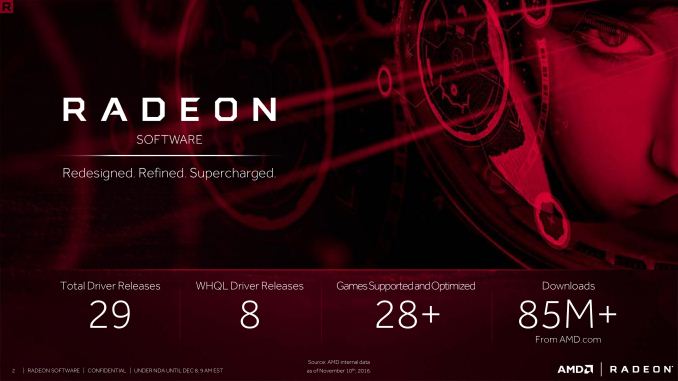
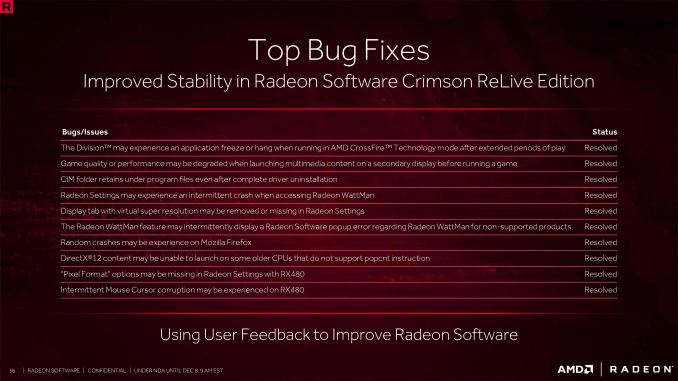
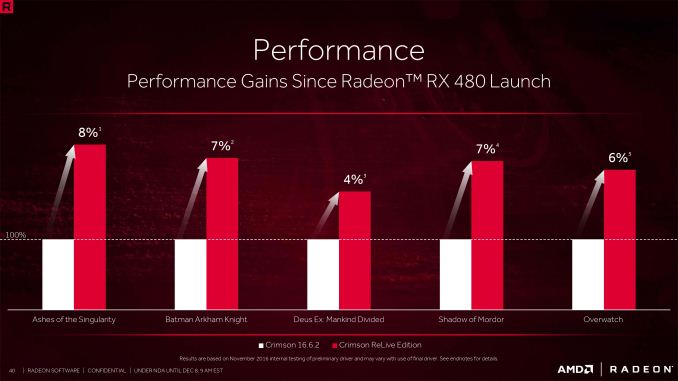
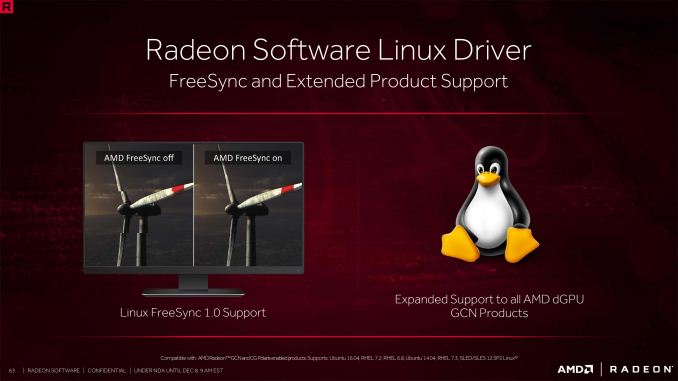








48 Comments
View All Comments
psychobriggsy - Friday, December 9, 2016 - link
AMD has been shipping proprietary AMDPRO drivers on Linux for quite some time, and if you want open source then AMD is the only choice really given Nvidia won't provide Pascal firmware images for Nouveau, and even then the AMD open source drivers are faster (in fact they compete very well with AMD's blobs on Linux now, they just don't provide OpenCL and Vulkan yet).Sure, if you game on Linux the Nvidia blobs are a bit faster than AMD overall, but it certainly isn't like a few years ago.
BrokenCrayons - Thursday, December 8, 2016 - link
Phrononix is my usual source for GPU benchmarks in Linux. I'm a regular reader over there and much of my current opinion was based on their performance analysis.YukaKun - Friday, December 9, 2016 - link
Benchmarks don't tell the day-to-day story. I have used both throughout the years and AMD has gotten ahead of the game now. People's complaints took some time, but they got their stuff together and they have zero things to have envy of nVidia's drivers.Performance not-withstanding, AMD is in a great shape now in the Linux world. In fact, I have to say it works wonders with SteamOS. Maybe I am a lucky one, but my 7970Ghz did not have a single issue playing all of the Linux ported titles and now the RX480 doesn't either. Outside of gaming, no issues either. It's been quiet sailing so far and I hope it remains that way.
I can't say the same thing with nVidia in my laptop. I still, after 10 years aprox, still don't have switchable graphics and I am scared of upgrading the proprietary binary, since I've had issues with it, even using genkernel.
Cheers!
BrokenCrayons - Friday, December 9, 2016 - link
Thanks for the information. I've been running a few older Nvidia GPUs (NVS 160m and 8400m GS) in my laptops without problems, but I don't use open source drivers. They experience has been very "sane" for my usage. I've yet to move my desktop with its GT 730 off Windows 7 which is largely a laziness thing as I already have an unused drive sitting in the case that just needs to be plugged in.I haven't personally tinkered with AMD graphics under Linux since I retired a couple of older laptops, one with a C-70 and another with an E-450 and their integrated GPUs. They were a pain to get working under Arch and Mint. I'm glad to hear that a current gen RX480 is working out for you. I might grab a RX460 in the next month or three and at that point I'll probably be more interested in transitioning to Linux and moving the system into a smaller case (microATX board in a full tower case...kinda a waste of space).
mr_tawan - Friday, December 9, 2016 - link
Bad news is, the latest AMD's RFC for DAL/DC get slammed today.psychobriggsy - Friday, December 9, 2016 - link
Yeah, I definitely sense that AMD's Linux devs were being held back by a higher up PHB regarding the HAL that was being imposed. Hopefully this major burn will allow them to do things properly at the kernel level even if it needs some linux-specific stuff in the drivers.IntoGraphics - Tuesday, January 3, 2017 - link
No.Read Phoronix for "It Looks Like AMDGPU DC (DAL) Will Not Be Accepted In The Linux Kernel" :
http://www.phoronix.com/scan.php?page=news_item&am...
VisS - Friday, December 9, 2016 - link
What Crap ?Colin1497 - Thursday, December 8, 2016 - link
Out of the box this looks really impressive. Time to start the download.One question: Technical reason that rebadged r9-2xx series cards get HDR10 in their r9-3xx guise while the original r9-2xx's don't? BIOS or marketing?
Colin1497 - Thursday, December 8, 2016 - link
Just realized how old I sound saying "start the download" like this was 1993 and it was going to take a week. It took a few seconds...